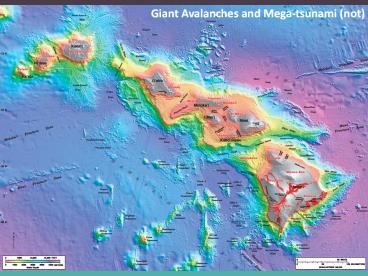Giant Avalanches and Mega-tsunami (not) - PowerPoint PPT Presentation
Title:
Giant Avalanches and Mega-tsunami (not)
Description:
Title: No Slide Title Author: Scott K. Rowland Last modified by: Scott Rowland Created Date: 10/3/2006 7:50:06 PM Document presentation format: On-screen Show – PowerPoint PPT presentation
Number of Views:199
Avg rating:3.0/5.0
Title: Giant Avalanches and Mega-tsunami (not)
1
Giant Avalanches and Mega-tsunami (not)
2
N coast of E. Molokai
3
WHAT CAUSED THE HUGE PALI? FAULTING? MARINE
EROSION? VALLEY EROSION? SOME COMBINATION OF
THESE?
Dana (1890) Thus such precipices are rather the
rule in the Hawaiian group and if
seashore erosion is not the origin, - as many
facts from the islands of the Pacific appear to
show, - fractures and subsidence must be.
4
Formation of a cliff (that might be, or has been,
mistaken for a fault or avalanche scarp) by
coalescence of amphitheater-headed valleys
(Modified from Stearns Vaksvik 1935)
5
(No Transcript)
6
Topographic evidence indicates the presence of
two large submarine landslides on the slope of
the Hawaiian ridge northeast of Oahu. One slide
is more than 150 km long and moved on a slope
with an overall gradient of about 2 degrees.
(Moore 1964)
However, recent detailed work on the
topo- graphy of the regiondoes not support
this hypothesis. The undersea hills are very
large as compared with the bumps on known
land- slides, and some of them have forms
charac- teristic of volcanic cones. The
Tuscaloosa (also called Tuscarora) Seamount, for
example, has a height of about 6,000 feet above
the surrounding sea floor, and its general
form suggests that it is probably a guyot
(Macdonald and Abbot 1970)
7
(Moore 1964)
8
GLORIA side-scan sonar data (smooth surfaces show
up as dark, rough surfaces show up as bright)
(Moore et al. 1989)
9
(Moore et al. 1989)
10
17 large landslides in principal Hawaii region
Represents 6 million yrs ( 1 every 350,000
yrs) Two Kinds slumps (prolonged, progressive
formation) and catastrophic debris avalanches
Off-shore failure accelerates on-shore erosion
Debris avalanches are likely to produce huge
tsunami locally, but Would they be Pacific-wide?
11
Nuuanu Debris Avalanche
Kaena Slump
Wailau Slide
Waianae Slump
(slide by John Sinton)
12
after Moore (1964)
13
Profiles through E. Oahu showing landslide
blocks (3x vertical exaggeration)
Landslide headwall
E. Oahu - restored
Waianae
Diagrams by Moore and Clague 2002, slide by
John Sinton
14
(No Transcript)
15
(No Transcript)
16
Moore and Moore (1988) the Hulopoe Gravel was
deposited by giant waves (megatsunami) generated
by large submarine landslides.
Moore and Moore (1988) also speculated that other
high-level deposits elsewhere in Hawaii might
also be explained with this mechanism
(slide by John Sinton)
17
- Rubin et al. (2000) dated carbonates from the
deposit - Age correlates with stratigraphic height
- None of the clasts indicate a 105 ka event
(slide by John Sinton)
18
The deposit is too old to have been produced from
the Alika Slide The presence of internal
stratigraphy indicates it is not the product of a
singe event (or wave) These results favor
deposition from rising and falling sea level over
a period of more than 100,000 years (scenario B).
Rubin et al. 2000
(slide by John Sinton)
19
Felton et al. 2000 recognized up to 14
different beds in the unit, and 8 different
disconformities in the 9-m thick type
section. Three of the disconformities are
associated with truncated paleosols The
deposition of the Hulopoe Gravel was not
continuous. At least one bed is clearly alluvial
(slide by John Sinton)
20
The boulders are sorted by age Different sea
levels? Multiple tsunami? Enough time between
events To develop soil?
1 m
21
(No Transcript)
22
Photo by Peter Mouginis-Mark, HIGP/SOEST
23
Ward SN (2001) Landslide Tsunami. J Geophys Res
106 11201-11215
24
Ward SN (2001) Landslide Tsunami. J Geophys Res
106 11201-11215
25
Ward SN (2001) Landslide Tsunami. J Geophys Res
106 11201-11215
26
Ward SN, Day S (2001) Cumbre Vieja Volcano
Potential collapse and tsunami at La Palma,
Canary Islands. Geophys Res Lett 283397-3400
27
Ward Day (2001)
http//geology.com/news/images/canary-islands-la-p
alma.jpg
28
http//www.geo.arizona.edu/7Eandyf/LaPalma/1949-F
aults.jpg
29
(No Transcript)
30
http//geology.com/news/2005/09/atlantic-ocean-tsu
nami-threat.html
31
http//www.lapalma-tsunami.com/reactions.html
32
A web version of this is at
http//www.drgeorgepc.com/TsunamiMegaEvaluation.ht
ml
33
http//www.tsunamisociety.org/PressReleases.html
34
(Lamb et al. 2007)
35
Giant avalanches as a mechanism to give a head
start to large amphitheater-headed valleys
Kohala The giant avalanche speeds up erosion and
thereby enhances stream piracy.
(Lamb et al. 2007)
36
(Lamb et al. 2007)
37
CREATION OF A SUBMERGED TERRACE REPRESENTING THE
END OF THE THOLEIITE SHIELD
38
(No Transcript)
39
Avalanche scar (shortly before the end of
tholeiite shield- building)
Coastline when tholeiite shield stopped
erupting (1.5 million years ago)
Kalaupapa (rejuvenation) 350,000 years old
Coastal terrace wave-cut platform reef, from
pre- Kalaupapa low sea-level Time (420,000
or 350,000 years ago)
Clague Moore (2002)
40
(No Transcript)
41
(No Transcript)
42
(No Transcript)
43
(No Transcript)































